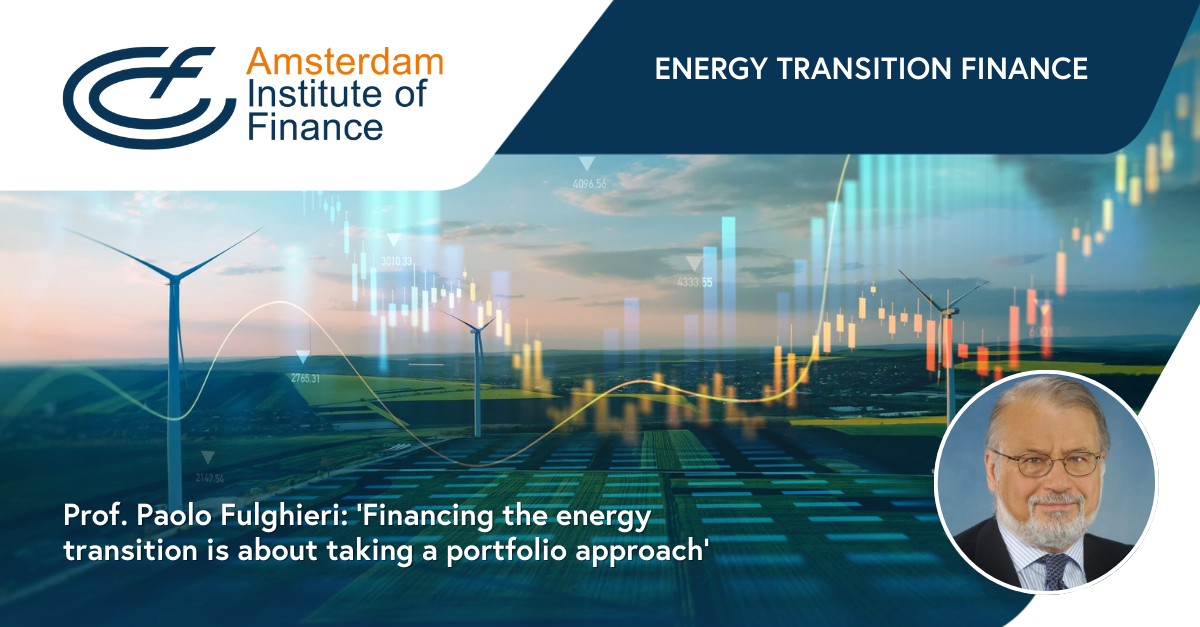
To reach the Paris climate goals, massive investments are needed in the energy transition. However, renewable energy sources are volatile, both in terms of supply and price.
This means investors looking to finance the transition should take a portfolio approach, argues Paolo Fulghieri, Professor of Finance at the Kenan-Flagler Business School, University of North Carolina. He also teaches the Energy Transition Finance program at the Amsterdam Institute of Finance.
“In 2024, investment in the energy sector is estimated to be in excess of three trillion dollars. Of these, two trillion dollars go to clean energy. Even more massive investments are needed to meet the Paris climate goals. The International Energy Agency estimates these are required to double until 2030 to about four trillion dollars”, Fulghieri lays out.
“Renewable energy sources are dependent on atmospheric conditions. This is the biggest challenge of renewable energy.”
Paolo Fulghieri, Professor of Finance University of North Carolina

Taking a broad view
Though renewable energy, energy from sources such as wind, solar, and geothermal, is an important part of the mix, for investors it is critical to take a broad view when looking to invest in the transition. “Investment in infrastructure, that is, making improvements in the grid, is also needed, as well as investment in storage capacity. Moreover, gas is going to be part of the equation. So, until the technology is fully developed, we need to take a portfolio approach.”
Volatility
The underlying reason for this is that there are inherent risks that come with renewable energy. First and foremost, it is very volatile. “Renewable energy sources are dependent on atmospheric conditions. This is the biggest challenge of renewable energy, and has both technological and economic implications. We need to understand the implications of this volatility in the market and should know how to deal with it”, Fulghieri says.
The unreliability of renewable energy strains grids, he elaborates. “This can cause blackouts and damage to infrastructure. So when there is a lack of supply, of course there is a blackout, but there can also be a blackout when there’s too much energy in the system.”
Impact on valuations
This also leads to volatility in electricity pricing. “When the supply is abundant, say during daytime when there is less energy demand, and a greater energy supply, wholesale prices may become negative. Such volatility has an effect on revenue projections for energy investment projects, and valuations”, Fulghieri says.
There are different avenues to resolve these issues. One is investment in infrastructure. This can help to distribute energy from where there is a surplus, to where there are shortages, thereby evening out the unbalances.
Energy storage
Another solution is energy storage. Fulghieri: “There’s a lot of investment in batteries. Both the capacity as well as other features of batteries are improving. The traditional form is the lithium-based battery, this, however, comes with supply chain problems because a lot of the raw materials are located in China. So, an interesting development is that a lot of new storage technologies are being developed. Storage based on compressed air, sand, or spinning wheels. Many new technologies are coming in.”
On top of that, traditional electricity providers will fill the gaps, making up for shortages in electricity supply when these occur. “It is important to understand that traditional carbon-based suppliers will for some time coexist with renewable suppliers. There’s no way we can give these up. They will play a key role until we have a fully reliable supply of renewable energy.”
“Things such as fiscal incentives affect the demand for renewable energy sources. Unfortunately, this is determined by political calculation.”
Technology becoming obsolete
When it comes to investment in the energy transition, there are other risks investors have to take into account, Fulghieri points out. “There is the risk of technology becoming obsolete when newer technologies come online.” This is related to the long timeframes that come with energy investments. “For example, an infrastructure investment might take as long as fifteen years to complete.”
Another risk is related to the regulatory environment. “Things such as fiscal incentives affect the demand for renewable energy sources. Unfortunately, this is determined by political calculations, thus creating a lot of uncertainty. At the same time risk management requires a stable environment with a stable and predictable regulatory framework.”
Pricing risks
“Ultimately it’s about how you price these risks”, Fulghieri says. This is not an easy task. The inherent volatility in electricity pricing that comes with alternative energy, is not recognized in traditional valuation measures such as the levelized cost of energy, or LCOE. This is used to compare the cost effectiveness of alternative energy technologies. “Option pricing techniques can help to assess these value drivers”, Fulghieri concludes.
Prof. Paolo Fulghieri teaches the programs Energy Transition Finance (NEW), Initial Public Offerings, and Project Finance and PPPs at Amsterdam Institute of Finance. Learn more & reserve your place here.